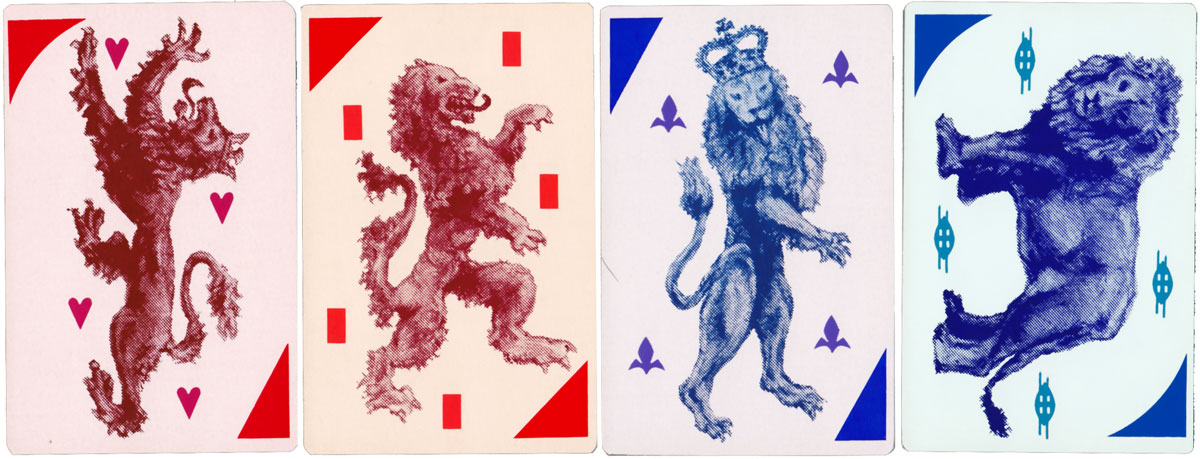The Game of Four Queens
In 1988 the Danish School of Design set the examination project to design a pack of playing cards. Thomas Damkier designed this royalty deck, called “Dronningespillet” (Game of Queens).
The Game of Four Queens designed and created by Thomas Damkier, 1988
In 1988 the Danish School of Design set the examination project to design a pack of playing cards. All students passed the examination. Thomas Damkier was the designer of this royalty deck, which he called “Dronningespillet” (Game of Queens) since his concept was based upon the - at that time - four reigning queens: (in alphabetical order by kingdom) Margerethe II of Denmark, Elizabeth II of Great Britain, Beatrix of the Netherlands and Ntambi of Swaziland.
One of Thomas Damkier's ideas was to create a closer relation between the design of the courts and the number cards. The geometrical forms used for the number card designs are derived from the suit marks and the same forms are repeated in the appropriate court card designs. The Queens are framed in cropped versions of the suitmarks, the Kings and Princes again are framed by derived variations of the same forms. The number cards are divided into high and low values. Spades and Hearts are smaller than Clubs and Diamonds. The four lions on the Jokers are lions that - except for the African lion - can be found in the respective countries' heraldry.
Instead of using the elaborate laminated boards that the other students used for their presentations, Thomas Damkier, who was disabled, succeeded in presenting his work as a proper card deck.
Thomas Damkier died of sclerosis a few years later.
REFERENCES
Jensen, K. Frank: Royalty on Danish Playing Cards, The Playing-Card vol.32 no.1, IPCS, July-Aug 2003.
Images and notes courtesy K. Frank Jensen, who was one of the external examiners of the project and whose article describing the cards forms the basis of this page.

By Simon Wintle
Member since February 01, 1996
I am the founder of The World of Playing Cards (est. 1996), a website dedicated to the history, artistry and cultural significance of playing cards and tarot. Over the years I have researched various areas of the subject, acquired and traded collections and contributed as a committee member of the IPCS and graphics editor of The Playing-Card journal. Having lived in Chile, England, Wales, and now Spain, these experiences have shaped my work and passion for playing cards. Amongst my achievements is producing a limited-edition replica of a 17th-century English pack using woodblocks and stencils—a labour of love. Today, the World of Playing Cards is a global collaborative project, with my son Adam serving as the technical driving force behind its development. His innovative efforts have helped shape the site into the thriving hub it is today. You are warmly invited to become a contributor and share your enthusiasm.
Related Articles

Modern Swiss-German Pattern (carta.media)
Modernizing tradition: balancing clarity and continuity in regional card design.

Tactics Design
Late modernist Japanese playing cards designed by Masayoshi Nakajo for Tactics Design.

The Decadent Deck
Studies in the eroticism of the female body by Inge Clayton.

Historic Shakespeare
“Historic Shakespeare” playing cards featuring Shakespearean characters by Chas Goodall & Son.

Sunday Night / Nichiyoubi no Yoru
An irreverent, avant-garde deck unofficially titled "Nichiyoubi no Yoru" (Sunday Night), designed by...

Emilio Tadini playing cards
Beautiful dreamlike playing card designs by Emilio Tadini.

Polish Kings and Queens – red deck
Polish kings and queens plus the court jester, illustrated in a distinctive style inspired by histor...

Zürcher Festspiel 1903
Swiss-suited pack designed by Robert Hardmeyer featuring figures from art and politics.

Never Mind the Belote
Limited edition Belote pack with designs by a collective of 24 street artists.

Playing card designs by Franz Exler
Reconstruction of playing cards from the original 1903 designs.

MITSCHKAtzen
Clever cat designs by the Austrian artist and illustrator Willi Mitschka.

22 Pittori in 22 Arcani
Collaborative Tarot with contributions from 22 different Italian artists including Menegazzi and Tav...

Whist by Ditha Moser
Ditha Moser created this minimalist Whist deck in 1905, in the style of the Vienna Secession art mov...

Keith Haring playing cards
Energetic graffiti images by the American artist Keith Haring.

Jim Lyngvild playing cards
Photographs of Danish royalty as imagined by fashion designer Jim Lyngvild.

Carte di Natale
Designed by Pier Canosa as a Christmas pack for the Cortina Art Gallery in Milan.
Most Popular
Our top articles from the past 28 days







